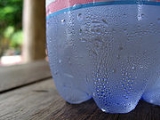
Condensation
Overview
State of matter
States of matter are the distinct forms that different phases of matter take on. Solid, liquid and gas are the most common states of matter on Earth. However, much of the baryonic matter of the universe is in the form of hot plasma, both as rarefied interstellar medium and as dense...
from gaseous phase into liquid phase, and is the reverse of vaporization
Vaporization
Vaporization of an element or compound is a phase transition from the liquid or solid phase to gas phase. There are three types of vaporization: evaporation, boiling and sublimation....
. When the transition happens from the gaseous phase into the solid phase directly, the change is called deposition
Deposition (physics)
Deposition is a process in which gas transforms into solid . The reverse of deposition is sublimation.One example of deposition is the process by which, in sub-freezing air, water vapor changes directly to ice without first becoming a liquid...
.
Condensation is initiated by the formation of atomic/molecular clusters of that species within its gaseous volume—like rain drop or snow-flake formation within clouds—or at the contact between such gaseous phase and a (solvent) liquid or solid surface.
A few distinct reversibility scenarios emerge here with respect to the nature of the surface.
- absorption into the surface of a liquid (either of the same species or one of its solvents)—is reversible as evaporationEvaporationEvaporation is a type of vaporization of a liquid that occurs only on the surface of a liquid. The other type of vaporization is boiling, which, instead, occurs on the entire mass of the liquid....
. - adsorptionAdsorptionAdsorption is the adhesion of atoms, ions, biomolecules or molecules of gas, liquid, or dissolved solids to a surface. This process creates a film of the adsorbate on the surface of the adsorbent. It differs from absorption, in which a fluid permeates or is dissolved by a liquid or solid...
(as dew droplets) onto solid surface at pressures and temperatures higher than the specie's triple pointTriple pointIn thermodynamics, the triple point of a substance is the temperature and pressure at which the three phases of that substance coexist in thermodynamic equilibrium...
—also reversible as evaporation. - adsorption onto solid surface (as supplemental layers of solid) at pressures and temperatures lower than the specie's triple pointTriple pointIn thermodynamics, the triple point of a substance is the temperature and pressure at which the three phases of that substance coexist in thermodynamic equilibrium...
—is reversible as sublimationSublimation (physics)Sublimation is the process of transition of a substance from the solid phase to the gas phase without passing through an intermediate liquid phase...
.
Condensation commonly occurs when a vapour is cooled and/or compressed to its saturation limit
Dew point
The dew point is the temperature to which a given parcel of humid air must be cooled, at constant barometric pressure, for water vapor to condense into liquid water. The condensed water is called dew when it forms on a solid surface. The dew point is a saturation temperature.The dew point is...
when the molecular density in the gas phase reaches its maximal threshold.
Unanswered Questions

